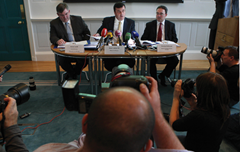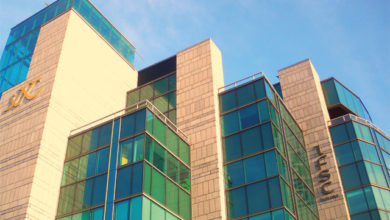Nama heads into political controversy
 Eamon Quinn examines the background to the banking crisis and the outlook for Nama, the ‘bad bank’ set up to help to deal with it.
Eamon Quinn examines the background to the banking crisis and the outlook for Nama, the ‘bad bank’ set up to help to deal with it.
One Wednesday early last April, various business, political and broadcasting reporters squeezed into a room on the lower of the two floors that house the National Treasury Management Agency (NTMA) in Treasury Buildings off Dublin’s south side canal.
Almost two decades after the agency was set up to deal with an earlier debt crisis, it was an appropriate setting for Minister for Finance Brian Lenihan publicly to endorse a report written by a consultant and property expert Peter Bacon that recommended the setting up of a new government ‘bad bank’ agency to deal with a new debt crisis. The National Asset Management Agency (Nama) was born. Only this time, the stakes were horribly greater than anything seen during the crisis years of the late 1980s.
The commercial property bubble was created by the hubris of a small group of boom-time players and bankers. Unfettered by the financial regulators, the lenders advanced tens of billions of euro to 50 property developers, a group so small that they could have been comfortably accommodated in any small community hall. The bursting of the bubble threatened nothing less than national bankruptcy.
The Irish property developers could no longer pay their loans on their so-called impaired assets of green and brown-field development land banks, half full or vacant new office blocks and new apartment blocks and housing estates here and in Britain. The banks would now face insolvency – and drag the economy down with them – if they were all at once to mark down the book value of the loans to reflect slump-time reality of commercial property market prices.
Scale
The scale of the crisis was so huge that the €87 billion of souring commercial property and associated lending on the books of five Dublin banks – AIB, Bank of Ireland, Anglo Irish, Irish Nationwide and EBS – amounted to almost exactly half of Irish gross national product, or about three times the diminished haul the Government hopes to raise in tax revenues this year. Worse, the country faced an interlinked economic and banking crisis few others faced.
Earlier that spring, individuals and big national and international companies had shifted deposits amounting to billions of euro from their Dublin bank accounts. They feared that the state guarantee put in place during the first of many crisis weekends, the previous September, would snap. Irish taxpayers had been co- opted to underwrite about €420 billion of deposits and bond debt liabilities in the Dublin banks.
Famously, Michael Somers, the Chief Executive of the NTMA, was later to reveal that the debt agency had for some time removed deposits it would normally place overnight with banks back to the haven of the Central Bank. The Government’s own debt agency feared for its money.
In January, to save it from collapse, the scandal-ridden Anglo Irish had been nationalised. And scarily, on the international sovereign debt markets, Ireland’s benchmark bond debt, or IOUs, were changing hands at interest rates of over 6 per cent, almost double the sovereign interest rates demanded of Germany.
By St Patrick’s Day, the wild chatter from the London markets was joined by euro- phobic commentary from abroad and closer to home, betting that the costs of the economic and banking crises would inevitably lead to Ireland’s expulsion and the break-up of the eurozone itself. In short, Nama was born in a cauldron. There was no denying that banks needed saving from their huge lending mistakes.
Leading Nama
At the April press briefing, Minister Lenihan was flanked by Bacon, who was later to become known as the architect of the Nama bad bank plan. Along the table sat NTMA boss Somers and Brendan McDonagh, the Financial Director of the NTMA, who was subsequently to be named as Nama’s interim Managing Director. John Corrigan, Head of the National Pension Reserve Fund, was also at the top table, and, around the room, sat Department of Finance officials, including Kevin Cardiff of the department’s Financial Services Division.
McDonagh and Corrigan had already poured through various reports on who owed what to the Dublin banks. A sampling exercise of the loan books had confirmed the extraordinary concentration of loans. The blueprint for Nama presented by Bacon that Wednesday would in a few weeks lead to the drafting of legislation that Lenihan plans to present to the Oireachtas on 16 September.
Bacon is a self-confident independent consultant who had been in and around government circles for the past decade. Long before the bursting of the property bubble he urged various Finance Ministers to turn down the heat on the property market by stopping tax breaks for investors. He was also on the board of a leading house building company. Bacon has the demeanour of a man who rarely suffers doubts about his own abilities but it would be going too far to believe that the big home-grown bits of the global property and banking crash here would have been avoided if his advice of earlier years had been followed.
Nama, Bacon believes, will prove to be the ‘bad bank’ tool the Swedes used to help solve a property and banking implosion that threatened their economy in the early 1990s. The version of his report, which was released to journalists in April, was one of the clearest, jargon- free and concise economic studies of its type. Nama, he said, will be no free lunch for a generation of Irish taxpayers, who will have to take on huge extra debts as
the unpalatable but necessary price of saving reckless lenders as the price of restoring confidence in the Irish economy. “Several well publicised regulatory failures and dubious practices at a number of institutions” had also heightened international concern, Bacon said at the time.
Discount
All the more unfortunate then that Bacon’s Nama report excised his estimates of the size of the discount or so-called haircut that Nama would pay lenders for their €87 billion of troubled property loans. At the time, officials unconvincingly claimed that disclosing the figure would compromise their negotiations with the banks. These were, of course, the same banks that had been bailed out by the taxpayers and had already gobbled up €11 billion in re-capitalisation tax cash to fill in just some of their black holes.
Not publishing estimates for the haircuts only delayed the inevitable debates and controversy about Nama until this month.
Of course Bacon was not working in a vacuum. In January, the European Commission and the European Central Bank had set of a kind of menu of possible banking-rescue schemes member states could adopt without breaking its state-aid rules.
Ireland, through Nama, and Germany chose to follow models of the bad bank – involving taxpayers buying bad assets
from the banks. Britain opted for an asset guarantee scheme, by which the loans would remain with the banks and British taxpayers would offer a type of insurance protection until the lenders write down the loans over a number of years. Bacon argued that the British scheme would fail to work here because international debt investors were already sceptical about the ability of only 4.5 million taxpayers here to take on a second guarantee.
Though speculation about the discount continued, very little officially was said about Nama until late July, when at another press briefing Lenihan announced the draft law to set up the bad bank. The legislation gives Leniha
n sweeping powers to stymie any possibility of a raft of constitutional challenges that would damage Nama from the start. Lenihan said he would indicate the range of the discounts Nama would pay the banks when he presented the legislation to the Oireachtas on 16 September.
The size of the discount has now become a matter of political controversy. The bad bank model means taxpayers take the costs of saving the banks upfront: pay too big a discount and the banks will need to come begging to the Government for more billions in taxpayer cash to fill their accounting black holes. But pay too small a discount and the taxpayer will lose out anyway as private investors, not taxpayers who took all the risk, could be the winners when the banks recover in future years.
However, there is growing evidence that the discount, when it is agreed later this year, will be much larger than the 20 per cent average many banking analysts, who are close to the banks, have assumed. Buy assets at the bottom of a market and even a small 2 or 3 per cent annual growth in property commercial prices could mean Nama would break even or, whisper it, even possibly turn a profit over the next 10 or 15 years.
At the time of writing, this writer believes that the average discount will be about 30 per cent, meaning that Nama will pay about €60 billion for the banks’ €87 billion of soured loans. The IMF in its June report on Ireland estimated two significant numbers for the cost of the Irish banking crisis: it estimated that the total Irish banks’ losses would amount to €35 billion over the so-called cycle and computed that the cost of recapitalising the banks would work out at about €26 billion.
Some €11 billion of the €26 billion bill has already been plugged courtesy of the taxpayers’ money that has already been injected into the three of the five Dublin banks that will deal with Nama. The banks have also written off amounts from pre- provision profits and raised capital through buying back, at a discount, some classes of bond debt. If a 30 per cent average discount were applied to the Nama loans, the IMF figures suggest that the five banks likely to deal with the bad bank would need about €6 billion or €7 billion in additional cash from the Irish taxpayer. Overseas analysts say that this may be found from a combination of exchequer and National Pension Reserve Fund resources.
Paying a larger than expected discount of 30 per cent may help the Government sell Nama to a sceptical electorate who perceive that property developers and banks getting off the hook. Radio phone- in chat shows crackle with dissent whenever the Nama word is up for discussion.
In truth, the Nama process, rather than being about the arithmetic of cleaning up the banking mess, has entered the political arena. Taxpayers will have to pick up the bill one way or the other.
National debt
Even without Nama the cost of the economic slump could push national gross debt here up to as much as 90 per cent of gross domestic product, equivalent to about €150 billion, by 2012, say the international sovereign debt experts. That is about the same debt level facing Germany and Britain. Include Nama, and the gross debt peaks at about 115 per cent of GDP, about the same as Italy’s.
Overseas analysts say that the Nama discount will be seen as a liability on Irish taxpayers no matter the way that Eurostat allows Ireland to account for the bill in the national accounts.
The academic critics of Nama, mostly centered in TCD and UCD, say nationalising the lenders would be best way of securing the interests of the taxpayer. Some of the academics acknowledge that a Nama scheme would be required, and the upfront costs, even under nationalisation, would be borne by taxpayers.
If approved by the Oireachtas, Nama hopes to have transferred and priced the first €20 billion of property loans by Christmas and a further €20 billion by February. The remaining €40 billion will be transferred by next June. The scale of the lending disaster is such that only 50 property developers together account for the first €20 billion of loans. These loans are likely to be the most difficult to unpick because many were wrapped in offshore tax-vehicles designed to reduce the developers’ income tax bills. Many of the same accountancy firms who helped construct the tax-efficient companies will likely be hired as advisers to Nama to help unpick the loans.
Nama will take control of €55 billion of loans across Ireland, of which an estimated €5 billion is believed to be advanced on projects around Belfast. About €25 billion of the loans are in the south east of England, including central London, and other smaller amounts are spread into English provincial cities and the US.
Nama’s success depends on the speed of any worldwide recovery. Nama, along with the co-opted taxpayer, will be anxiously scanning reports of commercial property prices in Dublin and London for some time to come.





